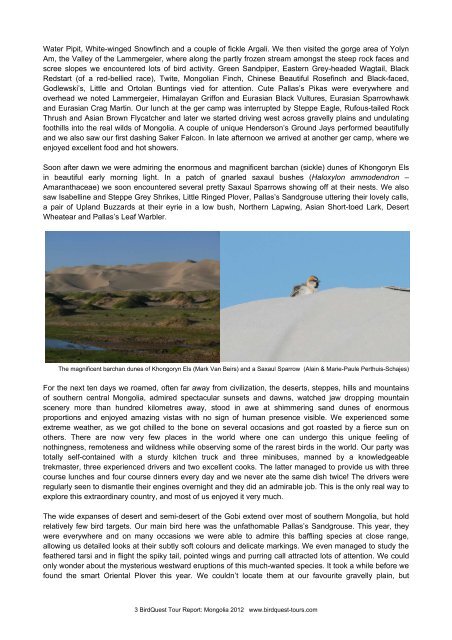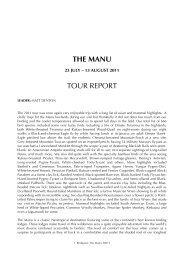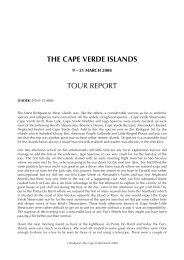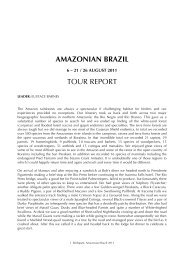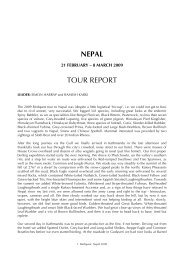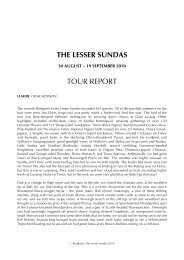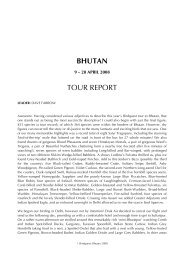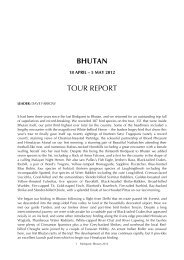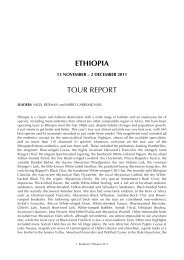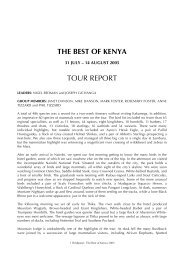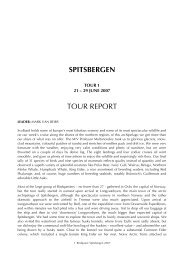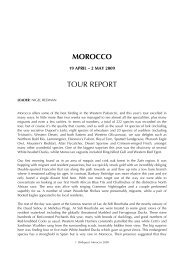MONGOLIA REP 12 - Birdquest
MONGOLIA REP 12 - Birdquest
MONGOLIA REP 12 - Birdquest
You also want an ePaper? Increase the reach of your titles
YUMPU automatically turns print PDFs into web optimized ePapers that Google loves.
Water Pipit, White-winged Snowfinch and a couple of fickle Argali. We then visited the gorge area of Yolyn<br />
Am, the Valley of the Lammergeier, where along the partly frozen stream amongst the steep rock faces and<br />
scree slopes we encountered lots of bird activity. Green Sandpiper, Eastern Grey-headed Wagtail, Black<br />
Redstart (of a red-bellied race), Twite, Mongolian Finch, Chinese Beautiful Rosefinch and Black-faced,<br />
Godlewski’s, Little and Ortolan Buntings vied for attention. Cute Pallas’s Pikas were everywhere and<br />
overhead we noted Lammergeier, Himalayan Griffon and Eurasian Black Vultures, Eurasian Sparrowhawk<br />
and Eurasian Crag Martin. Our lunch at the ger camp was interrupted by Steppe Eagle, Rufous-tailed Rock<br />
Thrush and Asian Brown Flycatcher and later we started driving west across gravelly plains and undulating<br />
foothills into the real wilds of Mongolia. A couple of unique Henderson’s Ground Jays performed beautifully<br />
and we also saw our first dashing Saker Falcon. In late afternoon we arrived at another ger camp, where we<br />
enjoyed excellent food and hot showers.<br />
Soon after dawn we were admiring the enormous and magnificent barchan (sickle) dunes of Khongoryn Els<br />
in beautiful early morning light. In a patch of gnarled saxaul bushes (Haloxylon ammodendron –<br />
Amaranthaceae) we soon encountered several pretty Saxaul Sparrows showing off at their nests. We also<br />
saw Isabelline and Steppe Grey Shrikes, Little Ringed Plover, Pallas’s Sandgrouse uttering their lovely calls,<br />
a pair of Upland Buzzards at their eyrie in a low bush, Northern Lapwing, Asian Short-toed Lark, Desert<br />
Wheatear and Pallas’s Leaf Warbler.<br />
The magnificent barchan dunes of Khongoryn Els (Mark Van Beirs) and a Saxaul Sparrow (Alain & Marie-Paule Perthuis-Schajes)<br />
For the next ten days we roamed, often far away from civilization, the deserts, steppes, hills and mountains<br />
of southern central Mongolia, admired spectacular sunsets and dawns, watched jaw dropping mountain<br />
scenery more than hundred kilometres away, stood in awe at shimmering sand dunes of enormous<br />
proportions and enjoyed amazing vistas with no sign of human presence visible. We experienced some<br />
extreme weather, as we got chilled to the bone on several occasions and got roasted by a fierce sun on<br />
others. There are now very few places in the world where one can undergo this unique feeling of<br />
nothingness, remoteness and wildness while observing some of the rarest birds in the world. Our party was<br />
totally self-contained with a sturdy kitchen truck and three minibuses, manned by a knowledgeable<br />
trekmaster, three experienced drivers and two excellent cooks. The latter managed to provide us with three<br />
course lunches and four course dinners every day and we never ate the same dish twice! The drivers were<br />
regularly seen to dismantle their engines overnight and they did an admirable job. This is the only real way to<br />
explore this extraordinary country, and most of us enjoyed it very much.<br />
The wide expanses of desert and semi-desert of the Gobi extend over most of southern Mongolia, but hold<br />
relatively few bird targets. Our main bird here was the unfathomable Pallas’s Sandgrouse. This year, they<br />
were everywhere and on many occasions we were able to admire this baffling species at close range,<br />
allowing us detailed looks at their subtly soft colours and delicate markings. We even managed to study the<br />
feathered tarsi and in flight the spiky tail, pointed wings and purring call attracted lots of attention. We could<br />
only wonder about the mysterious westward eruptions of this much-wanted species. It took a while before we<br />
found the smart Oriental Plover this year. We couldn’t locate them at our favourite gravelly plain, but<br />
3 BirdQuest Tour Report: Mongolia 20<strong>12</strong> www.birdquest-tours.com


